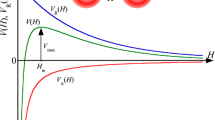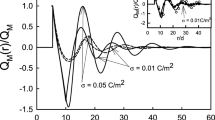Abstract
An algorithm is presented for calculating the stability ratio of a dispersion of spherical colloidal particles on the basis of the Derjaguin–Landau–Verwey–Overbeek theory. The finite ion size effect is taken into account by using the approximate form of ionic activity coefficients given by Carnahan and Starling. A simple approximate analytic expression for the stability ratio without involving numerical integration is also derived.

Finite ion size effect on the stability ratio of colloidal dispersions.



Similar content being viewed by others
References
Fuchs N (1934) Über die Stabilität und Aufladung der Aerosole. Z Phys 89:736–743
Reerink H, Overbeek JTG (1954) The rate of coagulation as a measure of the stability of silver iodide sols. Disc Faraday Soc 18:74–84
McGown DNL, Parfitt GD (1967) Improved theoretical calculation of the stability ratio for colloidal systems. J Phys Chem 71:449–450
Spielman LA (1970) Viscous interactions in Brownian coagulation. J Colloid Interface Sci 33:562–571
Honig EP, Roebersen GJ, Wiersema PH (1971) Effect of hydrodynamic interaction on the coagulation rate of hydrophobic colloids. J Colloid Interface Sci 36:97–109
Ruckenstein E (1978) Reversible rate of adsorption or coagulation of Brownian particles - effect of the shape of the interaction potential. J Colloid Interface Sci 66:531–543
Marmur A (1979) A kinetic theory approach to primary and secondary minimum coagulations and their combination. J Colloid Interface Sci 72:41–48
Prieve DC, Ruckenstein E (1980) Role of surface chemistry in primary and secondary coagulation and heterocoagulation. J Colloid Interface Sci 73:539–555
Kostoglou M, Karabelas AJ (1991) Procedures for rapid calculation of the stability ratio of colloidal dispersions. J Colloid Interface Sci 142:297–301
Gisler T, Borkovec M (1993) Stability ratios for doublet formation and for deposition of colloidal particles with arbitrary interaction potentials: an analytical approximation. Langmuir 9:2247–2249
Dukhin SS (1995) Electrochemical characterization of the surface of a small particle and nonequilibrium electric surface phenomena. Adv Colloid Interf Sci 61:17–49
Behrens AH, Borkovec M (2000) Influence of the secondary interaction energy minimum on the early stages of colloidal aggregation. J Colloid Interface Sci 225:460–465
Snoswell DRE, Duan J, Fornasiero D, Ralston J (2003) Colloid stability and the influence of dissolved gas. J Phys Chem B 107:2986–2994
Dukhin SS, Mishchuk NA, Loglio G, Liggieri L, Miller R (2003) Coalescence coupling with flocculation in dilute emulsions within the primary and/or secondary minimum. Adv Colloid Interf Sci 100-102:47–81
Wu KL, Lai SK (2005) Theoretical studies of the early stage coagulation kinetics for a charged colloidal dispersion. Langmuir 21:3238–3246
Urbina-Villalba G, García-Sucre M (2005) Role of the secondary minimum on the flocculation rate of nondeformable droplets. Langmuir 21:6675–6687
Guaregua MJA, Squitieri E, Mujica V (2006) A computational study of the stability ratios of spherical colloidal particles. J Mol Struct THEOCHEM 76:165–170
Guaregua MJA, Squitieri E, Mujica V (2009) A general algorithm using Mathematica 2.0 for calculting dlvo potential interactions and stability ratios in spherical colloidal particle systems. J Comput Meth in Science and Engineering 9:223–240
Guaregua MJA, Squitieri E, Mujica V (2009) Correlations between the maximum parameters of DLVO interaction energy curves and the electrolyte concentration. J Comput Meth in Science and Engineering 9:241–256
Chen KL, Smith BA, Ball WP, Fairbrother DH (2010) Assessing the colloidal properties of engineered nanoparticles in water: case studies from fullerene C60 nanoparticles and carbon nanotubes. Environ Chem 7:10–27
Rahn-Chique K, Puertas AM, Romero-Cano MS, Rojas C, Urbina-Villalba G (2012) Nanoemulsion stability: experimental evaluation of the flocculation rate from turbidity measurements. Adv Colloid Interf Sci 178:1–20
Ohshima H (2013) Simple analytic solution of the rate equations for the early-stage aggregation kinetics of colloidal particles. Colloid Polym Sci 291:3013–3016
Ohshima H (2014) Approximate analytic expression for the stability ratio of colloidal dispersions. Colloid Polym Sci 292:2269–2274
Urbina-Villalba G, García-Valera N, Rahn-Chique K (2015) Theoretical prediction and experimental measurement of the mixed flocculation/coalescence rate of ionic hexadecane-in-water nano-emulsions. RCEIF 4:1–17
Kobayashi M, Yuki S, Adachi Y (2016) Effect of anionic surfactants on the stability ratio and electrophoretic mobility of colloidal hematite particles. Colloids Surf A Physicochem Eng Asp 510:190–197
Lachin K, Le Sauze N, Raimondi NDM, Aubin J, Cabassud M, Gourdon C (2019) Estimation of characteristic coagulation time based on Brownian coagulation theory and stability ratio modeling using electrokinetic measurements. Chem Eng J 369:919–827
Derjaguin BV, Landau DL (1941) Theory of the stability of strongly charged lyophobic sols and of the adhesion of strongly charged particles in solutions of electrolytes. Acta Physicochim USSR 14:633–662
Verwey EJW, Overbeek JTG (1948) Theory of the stability of lyophobic colloids. Elsevier/Academic Press, Amsterdam
Ohshima H (1995) Effective surface potential and double-layer interaction of colloidal particles. J Colloid Interface Sci 174:45–52
Delgado AV (ed) (2000) Electrokinetics and electrophoresis. Dekker, New York
Lyklema J (2005) Fundamentals of interface and colloid science, Volume IV, Chapter 3, Elsevier/Academic Press, Amsterdam
Spasic A, Hsu J-P (eds) (2005) Finely dispersed particles: Micro-, nano-, and atto-engineering. CRC Press, Boca Raton
Ohshima H (2006) Theory of colloid and interfacial electric phenomena. Elsevier, Amsterdam
Adamczyk Z, Warszyński P (1996) Role of electrostatic interactions in particle adsorption. Adv Colloid Interf Sci 63:41–149
Das S, Chakraborty S (2011) Steric-effect-induced enhancement of electrical-double-layer overlapping phenomena. Phys Rev E 84:012501
Das S (2012) Electric-double-layer potential distribution in multiple-layer immiscible electrolytes: effect of finite ion sizes. Phys Rev E 85:012502
Andrews J, Das S (2015) Effect of finite ion sizes in electric double layer mediated interaction force between two soft charged plates. RSC Adv 5:46873–46880
Ohshima H (2016) An approximate analytic solution to the modified Poisson-Boltzmann equation: effects of ionic size. Colloid Polym Sci 294:2121–2125
Ohshima H (2017) Approximate analytic expressions for the electrostatic interaction energy between two colloidal particles based on the modified Poisson-Boltzmann equation. Colloid Polym Sci 295:289–296
Ohshima H (2018) Approximate expressions for the surface charge density/surface potential relationship and double-layer potential distribution for a spherical or cylindrical colloidal particle based on the modified Poisson-Boltzmann equation. Colloid Polym Sci 296:647–652
Ohshima H (2019) Finite ion size effect on the force and energy of the double-layer interaction between two parallel similar plates at arbitrary separations in an electrolyte solution. Colloid Polym Sci 297:35–43
Carnahan NF, Starling KE (1969) Equation of state for nonattracting rigid spheres. J Chem Phys 51:635–636
Attard P (1993) Simulation of the chemical potential and the cavity free energy of dense hard sphere fluids. J Chem Phys 98:2225–2231
Isralachvili JN (2011) Intermolecular and surface forcesThird edn. Academic/Elsevier, Amsterdam, p 79
Author information
Authors and Affiliations
Corresponding author
Ethics declarations
Conflict of interest
The author declares that he has no conflict of interest.
Additional information
Publisher’s note
Springer Nature remains neutral with regard to jurisdictional claims in published maps and institutional affiliations.
Rights and permissions
About this article
Cite this article
Ohshima, H. Finite ion size effect on the stability ratio of colloidal dispersions. Colloid Polym Sci 298, 1113–1117 (2020). https://doi.org/10.1007/s00396-020-04687-4
Received:
Revised:
Accepted:
Published:
Issue Date:
DOI: https://doi.org/10.1007/s00396-020-04687-4




